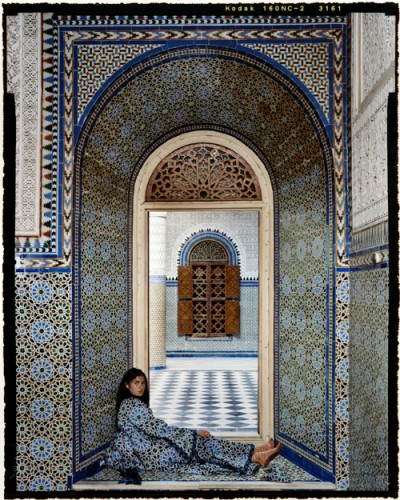Morrocan Artist Battles Orientalism with Photos

Artist Lalla Essaydi spoke of Orientalism, Western misconceptions of Moroccan women, and the critique of these ideologies in her photography during her lecture as part of the Jane L. and Robert H. Weiner Lecture in the Arts on Thursday, March 1.
During her talk, sponsored by the Department of Art and Art History, Essaydi said that she is deeply influenced by Orientalism but emphasizes that her relationship with the Orientalist tradition is a complicated one. “Orientalism continues to dominate contemporary depictions in film and popular media,” she explained. “My work aims to provide viewers with the understanding of the history of [the] depicted and rearrange the narratives.”
“I don’t have any solutions,” said Essaydi. “What I am trying to do is to show the reality in Moroccan societies instead of the stereotypes conveyed in public media.” She explained how she maintains the element of reality by “intentionally keep[ing] the rough edge because it’s important for people to understand that my work is completely free of manipulation.”
Essaydi celebrates the beauty that Western painters had found in Morocco, Egypt, and other Arabian countries. However, she criticizes the distorted and degraded view of the Eastern way of life, most strikingly on the representation of Muslim women.
According to Magda Siekert, senior lecturer in Middle East studies, the costumes that models wear in Essaydi’s photographs make female bodies blend in the background, suggesting the loss of women’s identities while highlighting the Western objectification of Moroccan women.
“I [was] very excited to meet the artist because I am also a Moroccan” said Hiba Aoid ’21. “I definitely agree with her [on Western misconception of Moroccan culture].” Aoid added, “[there are] a lot of things that I saw all the time but never thought about before.”
“As an Arabic TA (Teaching Assistant) and an Egyptian myself,” said Doha Ahmed, “it is very impressing to see how the complexity of photography presents female images from an artist’s point of view and highlights the diversity and depth of Moroccan society.”
“I am interested in the artwork at first. The art has a very unique perspective that I have never seen in any photographs before,” said Mihir Pyakuryal ’19. “I had my personal interpretation that the writings on the women’s bodies signify how they were silenced. But through the talk I found that [the writings] were more about the stories embedded in them.”
Essaydi discussed the difficulty and hard work that goes into taking her photographs, claiming that it is this work that transforms them into art. Most of the writing on her models’ bodies, robes, furniture and tiles are done by Essaydi herself. She usually keeps extra fabric on hand because she has to rewrite on the clothing whenever the models move. This can result in models standing in the same position for up to nine hours long to prevent the shooting process from being interrupted.
Essaydi’s work, including three of her photography series “Converging Territories”, “Les Femmes du Maroc” and “Harem” will be exhibited in the Trout Gallery until May 12.
Lalla Essaydi’s work is also being featured in a coordinated exhibition hosted by the Art Galleries of Lafayette College. More information can be found at troutgallery.org.



